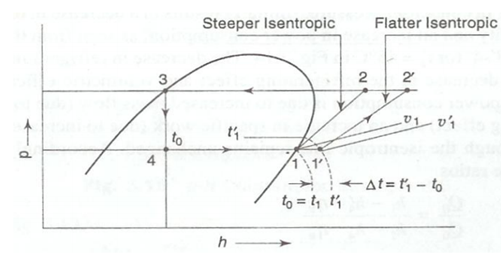Effect of Suction Vapour Superheat:
Superheating of the suction vapour is desirable in practice as it ensures full vaporization of the liquid in the evaporator before this enters the compressor. Also, in most of the refrigeration & air-conditioning systems, the degree of superheat serves like a means of actuating & modulating the capacity of the expansion valve. This has also been seen that for some of refrigerants such as Freon 12, maximum COP is got along superheating of the suction vapour.

Effect of Suction Vapour Superheat
this can be seen from above fig, that the effect of superheating of the vapour from t1= t0 to t1' is as:
(a) Enhancement in particular volume of suction vapour from v1 to v1,
(b) Enhancement in refrigerating effect from (h1 - h4) to (h1 - h4)
(c) Enhancement in particular work from (h2 - h1) to (h2'- h1')
This is to be noted down that (h2' - h1') is greater than (h2 - h1). It is because, though the pressure ratio is the similar for both of lines, the initial temperature t1,, is greater than t1 & the work given by the expression

Enhancement along the initial temperature. That's why isentropic lines on the p-h diagram become flatter in higher temperatures. A enhance in particular volume reduced the capacity. On the contrary, an enhancement in refrigerating effect shall enhance the capacity effect of super- heating is to theoretically decrease the capacity in ammonia systems and to enhance it in Freon 12 systems.